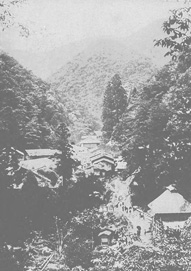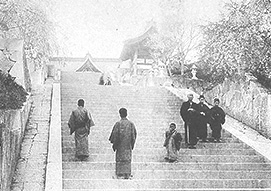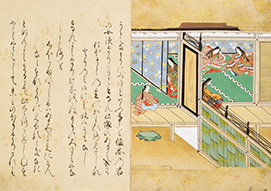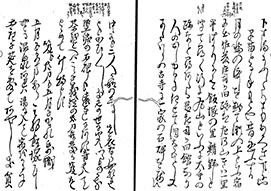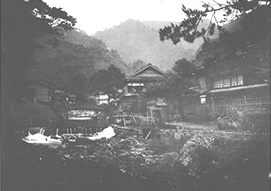Column <Tohoku>
4 Tohoku Hot Springs
Submerging one's body in a hot spring, nestled in the heart of the mountains towering black overhead.
Countless stars glitter in the sky between the mountains and the warm voices of the locals chatting can be heard through the steam, soothing the spirit.
Japan is one of the most blessed countries in the world when it comes to hot springs, and according to the Heisei 25 Nendo Onsen Riyo Jokyo (2013 Hot Spring Usage Conditions) compiled by the Ministry of the Environment (Website of the Ministry of the Environment (Japanese)), the Tohoku region in particular accounts for approximately 29% of Japan's total 3,159 hot springs. Every prefecture in the Tohoku region has an overwhelmingly large number of high-temperature springs which do not need any artificial heating and which have a variety of geographical conditions, scenery, and features as described below in "Major Hot Springs". Tohoku is an appealing hot spring region which can be enjoyed in a variety of ways.
Major hot springs, popular hot springs and hot springs with the most users
○Major hot springs
Dated 1915, The mineral springs of Japan; with tables of analyses, radio activity, notes on prominent spas and list of seaside resorts and summer retreats is an over-400 page voluminous source compiled from findings of surveys on major hot springs and hot spring regions throughout Japan by Ishizu Risaku et al. of the Imperial Hygienic Laboratory of the Home Ministry in Tokyo, was exhibited at the Panama-Pacific International Exposition.
From this it is known that the following hot spring regions in Tohoku were introduced to the world, and that there was a wide variety in the springs introduced including hot springs located in deep mountainous regions, such as Dai Hot Spring and Kamasaki Hot Spring; Asamushi Hot Spring from which the ocean can be seen; Owani Hot Spring, from which the heat is used to cultivate bean sprouts as a purveyor to the Tsugaru clan; Shibukuro (Tamagawa) Hot Spring, which once led to the Tamagawa being known as "Shi no Kawa" (River of Death) as a result of the strong acid sulfur spring; and Iizaka Hot Spring, one of the Oshu San Meito (the top three of springs with medicinal benefits of Fukushima-ken (Fukushima Prefecture), Miyagi-ken (Miyagi Prefecture), Iwate-ken (Iwate Prefecture), Aomori-ken (Aomori Prefecture) and a part of Akita-ken (Akita Prefecture)).
(Tohoku Region hot springs introduced in "The mineral springs of Japan")
Aomori-ken (Aomori Prefecture): Asamushi, Owani, Kuradate, Ikarigaseki Iwate-ken (Iwate Prefecture): Dai, Shidotaira, Osawa Akita-ken (Akita Prefecture): Oyuzawa, Oyu, Odaki, Shibukuro, Innai-yunosawa Miyagi-ken (Miyagi Prefecture): Onikobe, Tamatsukuri, Kamasaki Yamagata-ken (Yamagata Prefecture): Atsumi, Kaminoyama, Akayu, Onogawa, Sekine-yunosawa, Namekawa, Goshiki Fukushima-ken (Fukushima Prefecture): Yuno, Iizaka, Higashiyama, Kashi, Nekonaki, Bobata
○Popular hot springs
What type of hot spring areas were popular in the Meiji and Taisho eras?
The Naikoku Onsen Ichiran issued in January of 1878 provides a popularity ranking of hot spring areas throughout Japan in the manner of and using the terminology of sumo ranking lists.
The ranked hot springs are the Owani Hot Spring at the rank of "gyoji"(sumo referee), and Dai Hot Spring and Iizaka Hot Spring at the rank of "maegashira" (The 5th place rank), as well as Yunohama Hot Spring (Yamagata-ken), from which the Sea of Japan can be viewed and which is one of the Ou San Rakukyo (the top three springs in the entertainment and service district of Fukushima-ken, Miyagi-ken, Iwate-ken, Aomori-ken, Akita-ken and Yamagata-ken); Naruko Hot Spring (Miyagi-ken) which is one of Oshu San Meito (the top three springs with medicinal benefits of Fukushima-ken, Miyagi-ken, Iwate-ken, Aomori-ken and a part of Akita-ken)
; Mogami Takayu Hot Spring (Yamagata-ken) which is also named as "Zao Takayu" and known as one of Ou San Takayu (the top three springs in height of Fukushima-ken, Miyagi-ken, Iwate-ken, Aomori-ken, Akita-ken and Yamagata-ken); Iwakiyumoto Hot Spring (Modern-day Joban Yumoto Hot Spring (Fukushima-ken)) famous since long in the past and also known as Sabakoyu Hot Spring, and others.
○Hot springs with the most users
The Nihon Kosenshi issued in February of 1886 lists the spring qualities, addresses, general conditions and the number of users per year of hot springs throughout Japan. The following are the no. 1 most visited hot springs and number of visitors for each prefecture in the Tohoku region based on comparisons of the number visitors (excluding entries for which details are unknown).
- Aomori-ken: Kuradate Hot Spring (present-day Owani Hot Spring) - Approx. 3,000 visitors
- Iwate-ken: Dai Hot Spring - Approx. 4,300 visitors
- Akita-ken: Otaki Hot Spring - Approx. 3,718 visitors
- Miyagi-ken: Togatta Hot Spring - Approx. 19,648 visitors
- Yamagata-ken: Akayu Hot Spring - Approx. 17,998 visitors
- Fukushima-ken: Hashimoto Hot Spring (another name for Yuno) - Approx. 16,630 visitors
In addition, the earlier-mentioned The mineral springs of Japan lists the no. 1 through no. 63 major hot springs throughout Japan for 1909, ranked in order by the highest number of visitors; however the top for the Tohoku region in the list is Iizaka Hot Spring at no. 5, followed by Yuno Hot Spring (Fukushima-ken) at no. 9, Kaminoyama Hot Spring at no. 11, Takayu Hot Spring (Yamagata-ken) at no. 12, Owani Hot Spring at no. 20, and Akayu Hot Spring (Yamagata-ken) at no. 21.
The timing of the surveys and determination of popularity differ, so a simple comparison cannot be made; however the no. 1 spot for 6 prefectures in the Tohoku region in the Nihon Kosenshi is held by Togatta Hot Spring, which was a popular hot spring area since long before the publication, and the no. 2 spot, by a slim margin, is Miyagi-ken's Aone Hot Spring (Approx. 19,344 visitors); but these are not listed in the aforementioned "The mineral springs of Japan", and Dai Hot Spring which is listed in the same document and rankings lists approximately 1/5 of the number of visitors in the Nihon Kosenshi.
It seems that while some hot springs, like Owani Hot Spring, are listed as "sumo referees" in the rankings and are listed as "major hot springs" from scientific viewpoints such as large numbers of users, this does not hold true for all of the hot springs listed.
Hot springs loved by writers
Tohoku's hot springs have been well known since long in the past, with the Akiu Hot Spring in Miyagi-ken written about under the name "Notori no Miyu" in the Yamato Monogatari (a waka (31-syllable Japanese poem) and prose collection) from the Heian period.
On May 5, 1689, Basho stayed in the Iizaka Hot Spring area introduced in the "Hot springs with the most users" from the previous item, and Masaoka Shiki visited in July 1893 when retracing Basho's footsteps.
In addition, in 1911, Yosano Akiko visited the area with her husband Tekkan and novelist Sato Haruo and wrote about the Totsuna Bridge suspension bridge which at the time was supported by 10 steel wires, and the Higashiyama Hot Spring they also visited, in the waka collection Seigaiha. "It's like the pale blue wind blowing from Mt. Azuma hangs like a droplet from the Iizaka bridge suspended by its steel wires" "While soaking in the Aizu Higashiyama Hot Spring, I find myself wanting to stay soaking like this forever"
Medicinal springs
It has long been believed that hot springs have healing properties, and in the Edo period, "hot springs" were written about by traditional pharmacist Kaibara Ekiken in the Yojokun and by a Confucian doctor Kagawa Shuan in the IppondoFuyakusen Zokuhen, and the latter in particular mentions the Iizaka, Akayu, Kamasaki, Aone, Dai and other hot spring areas.
Following on, after the Curies discovered radium in 1902, in Japan the radioactive components of emanations from radium were said to be beneficial for all manner of illnesses and diseases, and a "radium boom" occurred in Japan.
Evidence of the excitement of the boom at the time can be seen from sales of "radium pipes" which were stuffed with absorbent cotton soaked in radium emanations, the opening of radium bathhouses in Tokyo Azabu and the increase in unscheduled trains from Ueno to Iizaka Hot Spring, which was promoted for its radium content.
Akita-ken's Tamagawa (Shibukuro) Hot Spring has a flow rate of 9,000 liters of 98 degree boiling hot water every minute, the largest flow rate for a single location in all of Japan, and is also a famous hot spring area for producing the "hokutoseki" mineral known as "Hokutolite" from hot spring deposits containing radium, and today is still a popular hot spring for those seeking treatment for illnesses and the spring's healing properties.
This Hokutolite was named in 1913 by mineralogist Jinbo Kotora, who discovered that the matter produced from the Beito Hot Springs in Taiwan was the same as that produced by the Tamagawa Hot Spring in Japan, and the hot spring is now a nationally designated Special Place of Scenic Beauty. In addition, in 1895, Kabayama Sukenori, the first Japanese Governor-General of Taiwan, and Fujita Tsuguakira, the then head of the medical division of the Taiwan Army of Japan and father to the painter Fujita Tsuguharu, inspected the Beito Hot Springs area, and a branch treatment hospital of the Taipei Military Eijyu Hospital was established at the hot spring as a facility for the treatment of war wounded.
The medicinal benefits of hot springs are not decided purely by the spring qualities, but are instead decided by the sum of a variety of factors including the geographical conditions, climate, environment, spring temperature, etc., and there are differences between individuals based on their physical condition and other factors.
The aspects of hot springs will differ just as the people who use them to soothe their bodies and minds each differ.
I hope that this article serves as an opportunity for you to find the hot spring which best suits you.
*Strictly speaking, hot springs and mineral springs are different, with hot springs being defined by the Hot Springs Law (promulgated July 10, 1948 and enacted on August 9 of the same year) and mineral springs being defined by the Nature Conservation Bureau of the Ministry of the Environment Guideline of Analytical Methods of Mineral Springs (Website of the Ministry of the Environment (Japanese)); however there is no hard distinction in many of the reference materials, so all such springs are uniformly referred to as "hot springs" in this article, regardless of differences in material titles.
Reference
- Ishizu Risaku, " Arranged according to Number of visitors (1909)" The mineral springs of Japan; with tables of analyses, radio activity, notes on prominent spas and list of seaside resorts and summer retreats, Sankyo, 1915 【551.23-I79m】
- Oishi Mahito, Onsen no Bunkashi, Maruzen, 1995 【DK261-E427】
- Okurasho, Insatsukyoku (ed.), Kanpo, vol.6445, (July 10, 1948) extra, Nihon Maikuro Shashin 【YC-1】
- Otsuka Yoshinori, Yakazu Domei (ed.), Kinsei Kanpo Igakusho Shasei, vol.65 (Kagawa Shuan, vol.1), Meicho Shappan, 1982 【SC851-120】
- Otsuka Yoshinori, Yakazu Domei (ed.), Kinsei Kanpo Igakusho Shasei, vol.69 (Kagawa Shuan, vol.5), Meicho Shappan, 1982 【SC851-120】
- Ohashi Kenichi, " Saisozo sareru‘Onsen Bunka’" Koryu Bunka, vol.9, July 2009 【Z71-N901】
- Miyakenoomi Matatari, Izumonoomi Hiroshima (ed.), Izumo no Kuni Fudoki, (pr.) 1728 【特1-1801】
- Miyakenoomi Matatari, Izumonoomi Hiroshima (ed.), Teisei Izumo Fudoki, vol.2, Kawachiya Kihee et al., 1806 【839-86】
- Kanzaki Noritake, Yamamoto Kotaro (ed.), Onsen Daihyakka, Gyosei, 1888 【GB645-E37】
- Saito Takashi et al., " Imejingu Pureto wo Riyoshita Tamagawa Onsensan Hokutoseki no Otojiogurafi" Proceedings of the 12th Workshop on Environmental Radioactivity, High Energy Accelerator Research Organization, 2011 【SC185-J55】
- Suzuki Yoshio, Gansekigaku Jiten, Asakura Shoten, 2005 【ME2-H19】
- Soyama Takeshi, " Nihon Shokuminchiki ni okeru Beito Onsen no Keisei" Rikkyo Daigaku Kankogakubu Kiyo, vol.2, March 2000 【Z71-C368】
- Naimusyo Eiseikyoku (ed.), Nihon Kosenshi, vol.3, Hokosha, 1886 【453.9-N249n】
- Hattori Yasuzo, "Waga Kuni Onsen 50nen no Ayumi" Onsen Kagaku, vol.20 (3・4), December 1969 【Z15-145】
- Fujiwara Yoshifusa et al., Ban Nobutomo (annotate), Shoku Nihon Koki, vol.1-8, Kishida Ginko et al., 1883 【149-9】
- Matsuo Basho, Hozumi Eiki, Oku no Hosomichi, Kikakudo, 1885 【138-68】
- Matsuda Tadanori, Onsen Kyoju no Tojiryoku, Shodensha, 2005 【Y75-H3508】
- Banzuke, vol.2, Sunakoshi, Tokubee et al., 1878 【特56-35】
- Yamato Monogatari, vol.5, Edo period (pr.) 【WB36-1】
- Yosano Akiko, Seigaiha, Yuhokan, 1912 【339-33】
- "Heisei 25 Nendo Onsen Riyo Jokyo (Heisei 26 Nen 3 Gatsumatsu Genzai) " (Website of the Ministry of the Environment)
- "Guideline of Analytical Methods of Mineral Springs (Heisei 26 Nen Kaitei)" (Website of the Ministry of the Environment)
